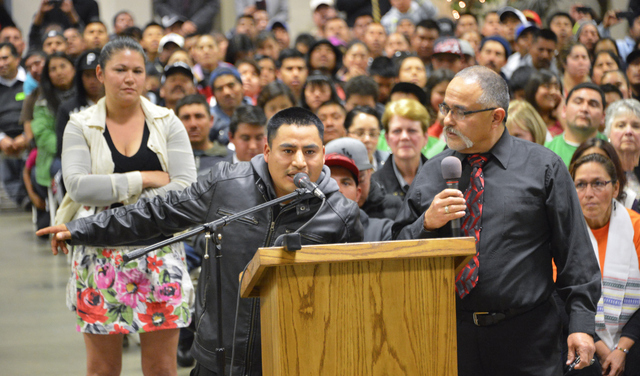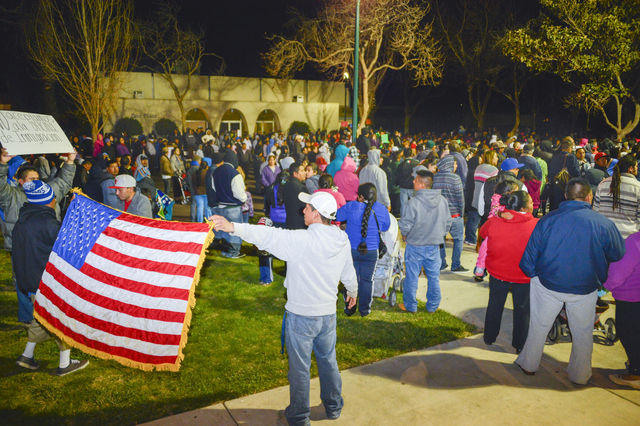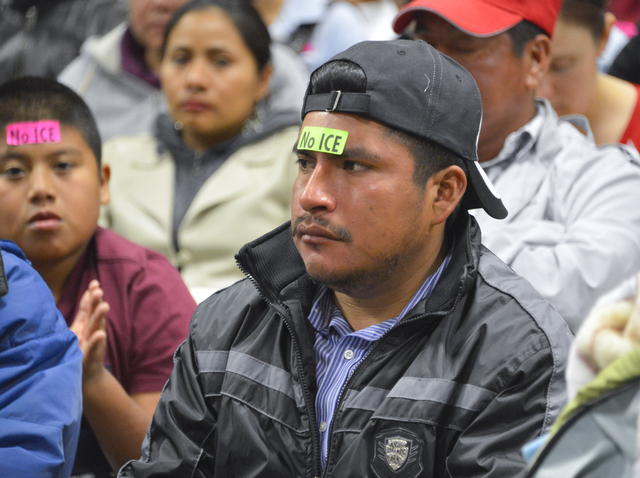Huge Protest Against Santa Maria ICE Center
Planning Commission Approves Building Permit

[Editor’s Note: A previous version of this story appears here.]
Since the Santa Maria Planning Commission approved a permit last Wednesday for a new federal Immigration and Customs Enforcement (ICE) facility, the possible effects of the decision — which is likely to be appealed to the Santa Maria City Council by the February 26 deadline — have reverberated throughout the community. Approximately 5,000 people showed up to the meeting, most of whom were opposed to the building and 1,500 of whom filled the city’s Fairpark convention center.
The project’s opponents contend ICE’s presence could lead to raids at the most and a culture of fear at the least, plus decreased property values and a depleted workforce. Said Hazel Putney-Davalos, a community organizer who works for the Central Coast Alliance United for a Sustainable Economy (CAUSE), “The cons certainly outweigh the pros.”

Not so, ICE officials have said. To be located at 740 West Century Street, near residential homes and not far from the planned North County Jail, the one-story building — which ICE would lease, not own — would comprise 9,700 square feet of an approximately 12,000-square-foot building, the rest of which will house medical offices. The center will take over the duties currently performed at the ICE facility at the Lompoc prison, said ICE spokesperson Lori Haley.
Most importantly, Haley said, the facility will only take custody of people convicted of serious crimes, who are transferred from regional jails or prisons. The facility would hold no more than 13 people and for no more than 12 hours; most detainees, after a few hours, would be bused down to a Los Angeles–area detention center. “The public should understand that ICE is focused on sensible, effective immigration enforcement, prioritizing our efforts first on individuals who present the greatest risk to the communities,” Haley said, who also stressed that the Santa Maria building would allow family visitation. “Wholesale raids are not something that ICE does. The community needs to understand this.”
Last year, ICE deported about 369,000 people nationwide, but the organization doesn’t track the number of deportations per city or county, Haley said. According to Sheriff’s Office spokesperson Kelly Hoover, while the number of ICE holds in place at the Santa Barbara County Jail can vary, the count usually hovers between 60-90 daily. However, the department doesn’t record how many of those inmates are awaiting trial or are convicted; how many are deported is also not tracked.
Police Chief Ralph Martin, appointed in late 2012, said that his department’s relationship with the city’s Latino community — which many said is being rebuilt in the wake of the strained dynamic under the former chief — wouldn’t be affected by ICE moving into town. He said that the facility could even benefit the area’s immigrant community, as they are often preyed upon by felons who know that victims won’t report crimes for fear of deportation; he said that the immigration status of victims and witnesses to crimes is “not a concern” of his department.
“I think that some people look at the structure as a building and not at what it represents to a great number of our residents,” said Robert Dickerson, the sole planning commissioner to vote against awarding the permit. He said he weighed the mental health of the city’s sizable Latino community when making his decision. “I wouldn’t want to be living looking over my shoulder all the time,” he said.

At previous city hearings on the building, the property was rezoned back to its original office-space classification, leading many to wonder how an ICE facility could meet that designation. Santa Maria Mayor Alice Patino, who has voted in favor of the building, said with an appeal likely, she plans to meet with homeowners, farmers, Congressmember Lois Capps, and ICE officials to suss out the concerns.Patino said this issue highlights the need for federal immigration reform, which has stalled in Congress. “This gets dropped on our doorstep as a City Council, and it shouldn’t be,” she said. “We need the workers, but they need to be here legally.” Capps, an advocate for immigration reform, has spoken out against ICE’s lack of communication with residents; her spokesperson said in a statement that she is working to “get important questions answered.”
Some said that the Trust Act (AB 4), a state law that went into effect in January, could play a small role in easing worries, as it lessens the power of the federal Secure Communities program by limiting the types of inmates who can be placed on ICE holds, but that the building’s likely proximity to the new jail could be a concern. Christina Fialho, an Arroyo Grande native whose national organization, Community Initiatives for Visiting Immigrants in Confinement (CIVIC), is working on the appeal, said that ICE’s presence in Santa Maria will “erode public safety and community trust.”
Whether the facility moves forward or not, Putney-Davalos said the meeting’s hefty turnout showed promise. Not only are people planning to rally against the center ahead of future hearings, she said, but they are talking about what their numbers could mean for upcoming Santa Maria City Council races. “We need to take steps to prevent this from happening again and get a Latino city councilmember elected this November,” she said. “Regardless of who can vote, they can knock on doors.”



